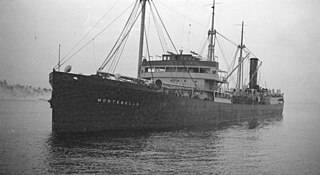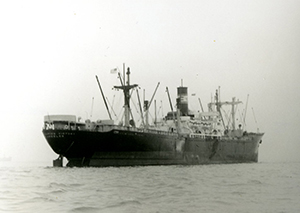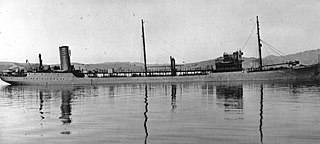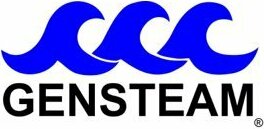Related Research Articles

SS Absaroka was a steamer, named after the Absaroka Range of mountains in Montana and Wyoming, completed in February 1918 for the United States Shipping Board (USSB) which briefly operated the ship. From 17 September 1918 to 4 March 1919 the ship was commissioned as USS Absaroka with the identification number IX-2581 in United States Navy and operated by the Naval Overseas Transportation Service.

The T2 tanker, or T2, was a class of oil tanker constructed and produced in large numbers in the United States during World War II. Only the T3 tankers were larger "navy oilers" of the period. Some 533 T2s were built between 1940 and the end of 1945. They were used to transport fuel oil, diesel fuel, gasoline and sometimes black oil-crude oil. Post war many T2s remained in use; like other hastily built World War II ships pressed into peacetime service, there were safety concerns. As was found during the war, the United States Coast Guard Marine Board of Investigation in 1952 stated that in cold weather the ships were prone to metal fatigue cracking, so were "belted" with steel straps. This occurred after two T2s, Pendleton and Fort Mercer, split in two off Cape Cod within hours of each other. Pendleton's sinking is memorialized in the 2016 film The Finest Hours. Engineering inquiries into the problem suggested the cause was poor welding techniques. It was found the steel was not well suited for the new wartime welding construction. The high sulfur content made the steel brittle and prone to metal fatigue at lower temperatures.

The Battle of Los Angeles, also known as the Great Los Angeles Air Raid, is the name given by contemporary sources to a rumored attack on the continental United States by Imperial Japan and the subsequent anti-aircraft artillery barrage which took place from late 24 February to early 25 February 1942, over Los Angeles, California. The incident occurred less than three months after the U.S. entered World War II in response to the Imperial Japanese Navy's surprise attack on Pearl Harbor, and one day after the bombardment of Ellwood near Santa Barbara on 23 February. Initially, the target of the aerial barrage was thought to be an attacking force from Japan, but speaking at a press conference shortly afterward, Secretary of the Navy Frank Knox called the purported attack a "false alarm". Newspapers of the time published a number of reports and speculations of a cover-up to conceal an actual invasion by enemy airplanes.
I-21 was a Japanese Type B1 submarine which saw service during World War II in the Imperial Japanese Navy. She displaced 1,950 tons and had a speed of 24 knots (44 km/h). I-21 was the most successful Japanese submarine to operate in Australian waters, participating in the attack on Sydney Harbour in 1942 and sinking 44,000 tons of Allied shipping during her two deployments off the east coast of Australia.

Sun Shipbuilding & Drydock Company (1917–1989) was a major shipbuilding company in Chester, Pennsylvania on the Delaware River.

Montebello was a steam oil tanker built in 1920–1921 by the Southwestern Shipbuilding Co. of San Pedro for Union Oil Company. It was designed to carry oil and petroleum products along the West Coast of the United States and Canada, as well as between the United States and Chile. In December 1941 the tanker was sunk on one of her regular trips by the Japanese submarine I-21.

The T3 tanker, or T3, are a class of seaworthy large tanker ships produced in the United States and used to transport fuel oil, gasoline or diesel before and during World War II, the Korean War and the Vietnam War. The T3 tanker classification is still used today. The T3 tanker has a full load displacement of about 24,830 tons.

SS Cedar Rapids Victory was the 77th Victory ship built during World War II under the Emergency Shipbuilding program. She was launched by the California Shipbuilding Company on January 14, 1945, and completed on February 17, 1945. The ship’s United States Maritime Commission designation was VC2-S-AP3 and her hull number was 77. Her operator was the American West African Line.

California during World War II was a major contributor to the World War II effort. California's long Pacific Ocean coastline provided the support needed for the Pacific War. California also supported the war in Europe. After the Japanese attack on Pearl Harbor on December 7, 1941, most of California's manufacturing was shifted to the war effort. California became a major ship builder and aircraft manufacturer. Existing military installations were enlarged and many new ones were built. California trained many of the troops before their oversea deployment. Over 800,000 Californians served in the United States Armed Forces. California agriculture, ranches and farms were used to feed the troops around the world. California's long coastline also put the state in fear, as an attack on California seemed likely. California was used for the temporary and permanent internment camps for Japanese Americans. The population grew significantly, largely due to servicemen who were stationed at the new military bases/training facilities and the mass influx of workers from around the U.S. in the growing defense industries. With all the new economy activity, California was lifted out of the Great Depression. Over 500,000 people moved to California from other states to work in the growing economy. California expanded its oil and mineral production to keep up with the war demand.

Larry Doheny was a tanker ship that sank during World War II. The 430 ft x 59 ft x 33 ft oil tanker had nine cargo tanks and was built in 1921 by the Sun Shipbuilding & Dry Dock Company in Chester, Pennsylvania. The first owner of Larry Doheny was the Norwegian America Line and it was called SS Foldenfjord. In 1928, the ship was sold to the Richfield Oil Company, who owned many gas stations throughout the west coast of the U.S. Larry Doheny’s homeport was Los Angeles.
SS Dorothy Phillips was a 2,119-ton cargo ship that was attacked during World War II. The Japanese submarine I-23 fired at her on December 24, 1941. Dorothy Phillips was damaged in the attack off the coast of Monterey, California. In the attack the ship's rudder was damaged and the ship could not steer and ran aground. Dorothy Phillips was built in 1918 by Albina Engine and Machine Works in Portland, Oregon. The attack helped put fear into the west coast and started the Battle of Los Angeles. SS Emidio and SS Larry Doheny were also attacked and sank off the West Coast of the United States. Dorothy Phillips was built by Albina Engine & Machine Works in a shipyard along the Willamette River in Portland, Oregon, United States. Dorothy Phillips was produced as a freighters for World War I as Point Loma. In 1937 she was sold and renamed Dorothy Phillips. In 1946 she was sold and renamed Karen Olson. In 1957 she was sold and renamed Rio Tigre. In 1962 she was scrapped.

H.M. Storey was an oil tanker built in 1921. She escaped an attack in California in 1941, but was sunk in an attack in 1943. She was owned by Standard Oil Company of California and built by Bethlehem Shipbuilding Corporation at the Alameda Works Shipyard with a hull# of 5312. She had a max capacity of 306,115 US gallons of fuel oil. Her keel was laid on 19 January 1921 and she was launched on 28 September 1921. Her sister ships are the SS F.H. Hillman and SS W.S. Rheem. She had a range of 7,717 miles, 10,763 DWT and a 16,000-ton displacement. She had a length of 500 feet (150 m), a beam of 68.2 feet (20.8 m) and a draft of 30 feet (9.1 m). The engines created 2,700 horsepower (2,000 kW), made by a triple-expansion engine with dual shaft and two screws. She had three Scotch boilers. Named for Henry Martin Storey, vice president of the Standard Oil Company.

The SS Agwiworld was a tanker ship that was able to evade an attack off the coast of California in the early days of World War II. Agwiworld was built by Sun Shipbuilding in Chester, Pennsylvania on the Delaware River. Agwiworld's keel was laid down on July 28, 1920. The vessel was launched on December 22, 1920, and delivered on January 19, 1921. Agwiworld was owned and operated by Richfield Oil Company and homeport was Los Angeles, California.

SS Barbara Olson was a cargo ship built in Wisconsin in 1918 as the SS Corrales. Barbara Olson was able to escape an attack off the coast of California in the early days of World War II. The Barbara Olson was built under a United States Shipping Board (USSB) contract in 1918 as the SS Corrales and renamed in 1940. On July 25, 1942, she was chartered by the US Army to transport supplies to the Territory of Hawaii as the USAT Barbara Olson for World War II. On January 14, 1946, her Army service ended. In 1964 she was run aground four miles (6.4 km) north of Pimentel, Peru and declared a total loss.

General Steamship Company was founded in 1920 in Houston, Texas, United States, as a Private Company, and now goes by Gensteam since 1996. General Steamship Company has a fleet of cargo ships that operate worldwide. Gensteam has a Gensteam Operations Desk website that tracks all shipping logistics. Gensteam headquarters is now in San Francisco, California. General Steamship Company was part owner of American Pacific Steamship Company in New York state and Los Angeles during and post World War II. American Pacific Steamship Company was founded in 1942 in New York City, and was previously called Los Angeles Tanker Operators Inc. which operated T2 tanker ships. During World War II the General Steamship Company and American Pacific Steamship Company were active with charter shipping with the Maritime Commission and War Shipping Administration.

World War II United States Merchant Navy was the largest civilian Navy in the world, which operated during World War II. With the United States fighting a world war in all the world oceans, the demand for cargo and fuel was very high. Cargo and fuel was needed around the world for the United States Navy, United States Army, United States Marine Corps, United States Army Air Forces, United States Coast Guard and the support of the allied nations of the United States. American steamship companies chartered ships from the Maritime Commission and War Shipping Administration to meet the demand. Many United States Merchant Marine ships were newly built in the Emergency Shipbuilding Program, other ships were older World War I ships that were put back in service, or private ships acquired under Emergency war requisitions. The Merchant Navy operated in the Pacific War and European war. Over 200 US Merchant ships took part in the D-day Normandy landings. To make a Normandy breakwater Harbor, called Mulberry harbour, 33 merchant ships were sunk 1,000 yards from shore. Some of the ghosts merchant ships used were damaged and others were deemed too old.
Pacific Tankers, Inc. of San Francisco, California, was founded in 1943 as a division of Joshua Hendy Corporation to operate fleet oilers for the United States Navy to support World War II efforts. Pacific Tankers, Inc. operated Mission Buenaventura-class oiler, a T2 tanker (T2-SE-A2). Each Pacific Tankers, Inc. tanker had a merchant crew of about 9 officers and 39 men. Pacific Tankers Inc. was a major tanker operator for the war with a fleet of over 60 tankers. Pacific Tankers, Inc. continued operations after the war.

Keystone Shipping Company of Philadelphia, Pennsylvania is a major shipping and transportation company. Keystone Shipping Company operates a fleet of ships for both dry bulk cargo and tankers. Since World War I, the Keystone Shipping Company has been active in the worldwide support of the United States Armed Forces. Keystone Shipping Company is part of the Ready Reserve Fleet program. Keystone Shipping Company was founded by Charles Kurz. Before Keystone Shipping Company, Charles Kurz was a shipping agent, commodities trader, and ship owner. Keystone Shipping Company headquarters is in Bala Cynwyd, Pennsylvania.

American Petroleum Transport Corporation was an oil shipping company founded in New York City in 1936. Daniel K. Ludwig was President of American Petroleum Transport Corporation. In 1939 American Petroleum Transport Corporation operated eight tanker ships from the Gulf of Mexico to Hatteras, North Carolina. American Petroleum Transport Corporation was active in supporting the World War II efforts. Some tanker ships American Petroleum Transport Corporation operated were sunk by German U-boat submarines. Daniel K. Ludwig founded in 1936 the company National Bulk Carriers.

Sieling & Jarvis Inc. was a shipping company that operated tanker ships and some cargo ships. Sieling & Jarvis was started by David B. Jarvis and Dick Sieling in New York City. Later David B. Jarvis was the company president and later became the sole owner of Sieling & Jarvis Inc. Mr. Sieling was the vice president and a partner in Sieling & Jarvis. Sieling & Jarvis supported the World War II effort by operating United States owned ships.
References
- ↑ "Tankers and Navy Oilers". www.shipbuildinghistory.com. Retrieved 19 October 2024.
- ↑ "California in World War II: The Attacks on the SS Montebello and the SS Idaho". www.militarymuseum.org. Retrieved 19 October 2024.
- ↑ "Ian Ferguson's Homepage, Part 1: SS Albertolite". merchantships2.tripod.com. Retrieved 19 October 2024.
- ↑ Panic on the Pacific: How America Prepared for the West Coast Invasion, By Bill Yenne
- ↑ "California in World War II: Victor Valley's Unsung Heros". www.militarymuseum.org. Retrieved 19 October 2024.
- ↑ "California in World War II: The Battle of Los Angeles". www.militarymuseum.org. Retrieved 19 October 2024.
- ↑ "THE ARMOR OF DEMOCRACY: VOLUNTEERISM ON THE HOME FRONT IN WORLD WAR II CALIFORNIA" (PDF). www.militarymuseum.org. Archived from the original (PDF) on 28 April 2022.
- ↑ Lotchin, Roger (29 April 2005). "The Triumphant Partnership California Cities and the Winning of World War II" (PDF). www.militarymuseum.org. Archived from the original (PDF) on 20 February 2022.
- ↑ "Fourth Antiaircraft Command Brigadere Pictorial Edition, August 1945" (PDF). www.militarymuseum.org. Archived from the original (PDF) on 17 April 2022.
- ↑ Panic on the Pacific: How America Prepared for the West Coast Invasion, By Bill Yenne